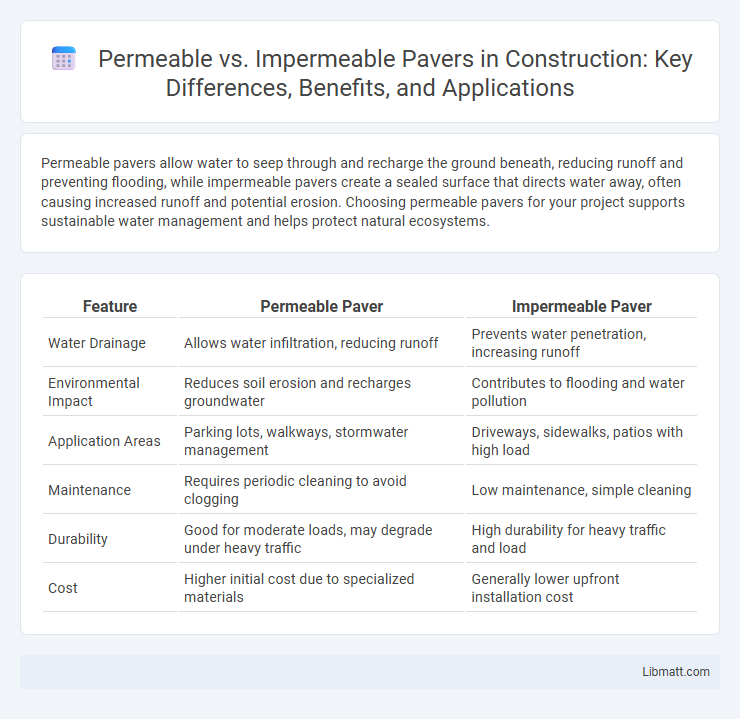Permeable pavers allow water to seep through and recharge the ground beneath, reducing runoff and preventing flooding, while impermeable pavers create a sealed surface that directs water away, often causing increased runoff and potential erosion. Choosing permeable pavers for your project supports sustainable water management and helps protect natural ecosystems.
Table of Comparison
| Feature | Permeable Paver | Impermeable Paver |
|---|---|---|
| Water Drainage | Allows water infiltration, reducing runoff | Prevents water penetration, increasing runoff |
| Environmental Impact | Reduces soil erosion and recharges groundwater | Contributes to flooding and water pollution |
| Application Areas | Parking lots, walkways, stormwater management | Driveways, sidewalks, patios with high load |
| Maintenance | Requires periodic cleaning to avoid clogging | Low maintenance, simple cleaning |
| Durability | Good for moderate loads, may degrade under heavy traffic | High durability for heavy traffic and load |
| Cost | Higher initial cost due to specialized materials | Generally lower upfront installation cost |
Introduction to Permeable and Impermeable Pavers
Permeable pavers allow water to pass through their surface, reducing runoff and promoting groundwater recharge, making them ideal for eco-friendly landscaping and stormwater management. Impermeable pavers, by contrast, prevent water infiltration, often leading to increased surface water runoff and potential drainage issues. Choosing the right option depends on your area's drainage needs and environmental impact considerations.
How Permeable Pavers Work
Permeable pavers function by allowing water to infiltrate through their porous surfaces and underlying layers, reducing runoff and promoting groundwater recharge. These pavers consist of permeable materials or gaps filled with aggregate that facilitate natural water filtration and prevent pooling. Your landscaping benefits from improved stormwater management and reduced erosion when using permeable pavers compared to impermeable alternatives.
Benefits of Permeable Pavers
Permeable pavers offer significant environmental advantages by allowing water to infiltrate through their porous surface, reducing stormwater runoff and promoting groundwater recharge. These pavers help prevent erosion and minimize the risk of flooding, contributing to sustainable urban drainage systems. Their ability to filter pollutants enhances water quality while providing durable, low-maintenance surfaces that improve urban landscaping and reduce heat island effects.
Drawbacks of Permeable Pavers
Permeable pavers often face challenges such as clogging from sediment buildup, which reduces their effectiveness in stormwater infiltration and requires regular maintenance. They may have higher upfront installation costs compared to impermeable pavers and can exhibit lower load-bearing capacity, making them less suitable for heavy traffic areas. Additionally, permeable pavers can be prone to weed growth and may not perform well in colder climates where freeze-thaw cycles cause surface damage.
How Impermeable Pavers Work
Impermeable pavers are designed with dense, non-porous materials that prevent water from passing through their surfaces, directing runoff to drainage systems or surrounding ground. They create a solid barrier that blocks water infiltration, often necessitating additional stormwater management solutions to handle surface runoff and reduce flooding risks. These pavers are commonly used in areas requiring strong load-bearing capacity with controlled water flow, such as driveways and urban sidewalks.
Benefits of Impermeable Pavers
Impermeable pavers provide excellent durability and load-bearing capacity, making them ideal for heavy traffic areas such as driveways and commercial spaces. Their non-porous surface prevents water infiltration, reducing the risk of soil erosion and structural damage to your property. These pavers also require less maintenance, as they do not allow weed growth or sediment buildup between joints.
Drawbacks of Impermeable Pavers
Impermeable pavers create significant water runoff due to their inability to absorb rainwater, increasing the risk of flooding and erosion in surrounding areas. These pavers contribute to urban heat island effects by retaining and radiating heat, which can raise local temperatures. Furthermore, impermeable surfaces reduce natural groundwater recharge, negatively impacting local aquifers and increasing strain on stormwater management systems.
Environmental Impact Comparison
Permeable pavers significantly reduce stormwater runoff by allowing water to infiltrate the soil, promoting groundwater recharge and reducing urban flooding. Impermeable pavers contribute to increased surface runoff, which can lead to water pollution and strain municipal drainage systems. The environmental impact of permeable pavers is more favorable due to their ability to mitigate heat islands and filter pollutants naturally.
Cost and Maintenance Analysis
Permeable pavers generally incur higher initial installation costs due to specialized materials and sub-base preparation, but offer long-term savings by reducing stormwater management expenses and minimizing drainage system maintenance. Impermeable pavers are less expensive initially but often lead to increased maintenance costs related to water runoff issues, such as erosion control and potential damage to surrounding infrastructure. Over time, permeable pavers provide a cost-effective solution by lowering environmental impact fees and decreasing the need for costly repairs linked with water accumulation.
Choosing the Right Paver for Your Project
Permeable pavers promote stormwater management by allowing water to infiltrate through the surface, reducing runoff and preventing erosion, making them ideal for environmentally sensitive areas. Impermeable pavers, constructed from dense materials like concrete or asphalt, offer durability and low maintenance but increase surface runoff, requiring effective drainage solutions. Selecting the appropriate paver depends on project goals such as sustainability, drainage needs, local climate, and regulatory requirements for water management.
Permeable paver vs impermeable paver Infographic

 libmatt.com
libmatt.com